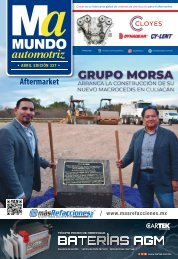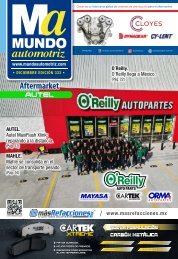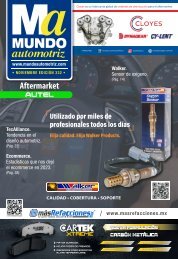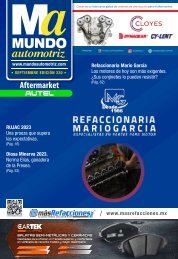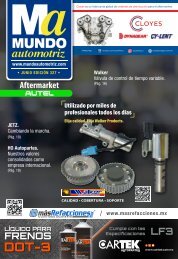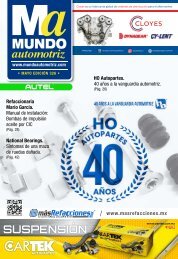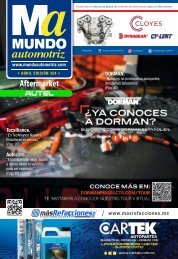Mundo Automotriz La Revista No. 242 Mayo 2016
Los especialistas en Aftermarket
Los especialistas en Aftermarket
Create successful ePaper yourself
Turn your PDF publications into a flip-book with our unique Google optimized e-Paper software.
ARTÍCULO TÉCNICO<br />
<strong>La</strong> dirección asistida es un sistema mediante el cual se reduce<br />
la fuerza (par de giro) que ha de efectuar el conductor<br />
sobre el volante de un coche para accionar la dirección.<br />
ORIGEN<br />
Hasta la década de 1920, cuando aparecieron los autobuses y<br />
camiones de gran peso, no hubo problemas para mover el volante.<br />
Fue el ingeniero Francis Davis quien inventó la dirección<br />
asistida. Para ello dejó su empresa: Pierce Arrow Motor Car<br />
Company y se puso a trabajar en un taller con un fabricante<br />
de herramientas.<br />
FUNCIONAMIENTO<br />
Cuando se giran las ruedas para cambiar la dirección del vehículo<br />
aparece una fuerza sobre el neumático que tiende a<br />
alinear la dirección de la rueda con la del vehículo. Esta fuerza<br />
se debe principalmente a la resistencia del neumático a ser<br />
deformado y la posición adelantada del centro de presiones<br />
respecto al centro de la rueda.<br />
<strong>La</strong> función de la dirección hidráulica es ayudar al conductor a<br />
vencer esta fuerza. De esta forma, la fuerza que deba de hacer<br />
el conductor más la que aplica la dirección serán iguales a la<br />
fuerza de autoalineamiento de la rueda:<br />
Trueda = Tasistencia + Tconductor<br />
<strong>La</strong> fuerza de autoalineamiento o resistencia que haga la rueda<br />
dependerá del vehículo y la velocidad. A menor velocidad,<br />
mayor resistencia. Una de las ventajas que aportan las direcciones<br />
electro-hidráulicas o eléctricas, es que al estar controladas<br />
electrónicamente se puede generar una asistencia<br />
variable en función de la velocidad. De esta forma se hace la<br />
conducción más cómoda.<br />
A velocidades bajas se necesitan pares mayores para girar<br />
las ruedas, si la dirección genera más asistencia, el conductor<br />
debe aplicar menos fuerza sobre el volante, lo que resulta en<br />
un esfuerzo menor por parte del conductor. Por el contrario,<br />
a velocidades mayores donde el par a aplicar es pequeño, la<br />
dirección apenas ayudará al conductor y será éste el que debe<br />
de hacer el esfuerzo. En este caso, si la dirección aplicara gran<br />
parte del esfuerzo necesario para girar las ruedas, el conductor<br />
debería aplicar una mínima parte, dando la sensación de<br />
inseguridad.<br />
Este último punto es un criterio subjetivo, ya que no todos los<br />
conductores tienen las mismas preferencias. Será por tanto el<br />
fabricante del vehículo el que deba elegir el nivel o cantidad<br />
de asistencia que se dará en cada momento en función a su<br />
criterio. Niveles de asistencia bajos obligarán al conductor a<br />
un mayor esfuerzo, generalmente resultado en una conducción<br />
más incómoda y cansada. Niveles de asistencia mayores<br />
obligarán al conductor a esfuerzos menores, pero conlleva<br />
una dirección más sensible a los movimientos del conductor.<br />
Ésta es una crítica que generalmente se aplica a las direcciones<br />
eléctricas, lo que se suele llamar “falta de tacto” o “que<br />
transmite poca información”.<br />
Otra de las ventajas del control electrónico, es que se puede<br />
variar el nivel de asistencia no sólo en función de la<br />
velocidad, sino también de la situación; por ejemplo, dife-<br />
Power steering is a system that through<br />
the torque force is reduced that the<br />
driver has to do to the steering wheel in<br />
a car to actuate to the steering.<br />
ORIGIN<br />
Until the 1920´s, when the buses and the<br />
heavy trucks appeared, there was no problem<br />
moving the steering wheel. It was the engineer,<br />
Francis Davis, who invented the power<br />
steering. To do that, he left his enterprise:<br />
Pierce Arrow Motor Car Company and went to<br />
work to a shop of a tool manufacturing.<br />
OPERATION<br />
When the wheels are rotated to change the<br />
vehicle´s steering appears a force under the<br />
wheel that tends to align the wheel steer with<br />
the vehicle´s. This force is due, mainly, to the<br />
resistance of the wheel to be deformed and<br />
the advanced position from the pressures concerning<br />
to the centre of the wheel:<br />
Twheel = Tresistance + TdriverThe<br />
The strength of the self-alignment or the resistance<br />
of the wheel doing it, depends on the<br />
vehicle and the speed. Lower the speed, more<br />
the resistance. One of the advantages that<br />
provides the electro-hydraulics or electronic<br />
is that, being electronically controlled can<br />
generate a variable assistance depending on<br />
the speed. This way, it makes the driving more<br />
confortable.<br />
At lower speeds, it is required higher torques<br />
to steer the wheels, if the steering generates<br />
more assistance, the driver most apply less<br />
strength to the steering wheel, which becomes<br />
in a less effort to the driver. On the opposite<br />
case, at higher speeds, where the torque to<br />
apply is smaller, the steering can hardly help<br />
the driver, and it will be he or she the one to<br />
will be making the efforts. In this case, if the<br />
steering is applying to the driver great part<br />
of the needed effort to steer the wheels, the<br />
driver should apply a minimum part, giving<br />
the sensation of insecurity.<br />
In the latter it is a subjective criterion, as not<br />
all the drivers have the same preferences.<br />
It will be, therefore the vehicle´s manufacturer<br />
the one who should choose the level or<br />
quantity of assistance that would be given in<br />
each moment accordingly to its point of view.<br />
Levels of lower assistance will force the driver<br />
to a bigger effort, mainly giving as a result<br />
an uncomfortable and tiring drive. Higher assistance<br />
levels will oblige the driver to lesser<br />
efforts, but that becomes a more sensible<br />
steering to the driver´s movements. This is a<br />
criticism that mainly is applied to the electric<br />
steering, what is usually called “lack of touch”<br />
or “it gives little information”.<br />
www.mundoautomotriz.com 69





